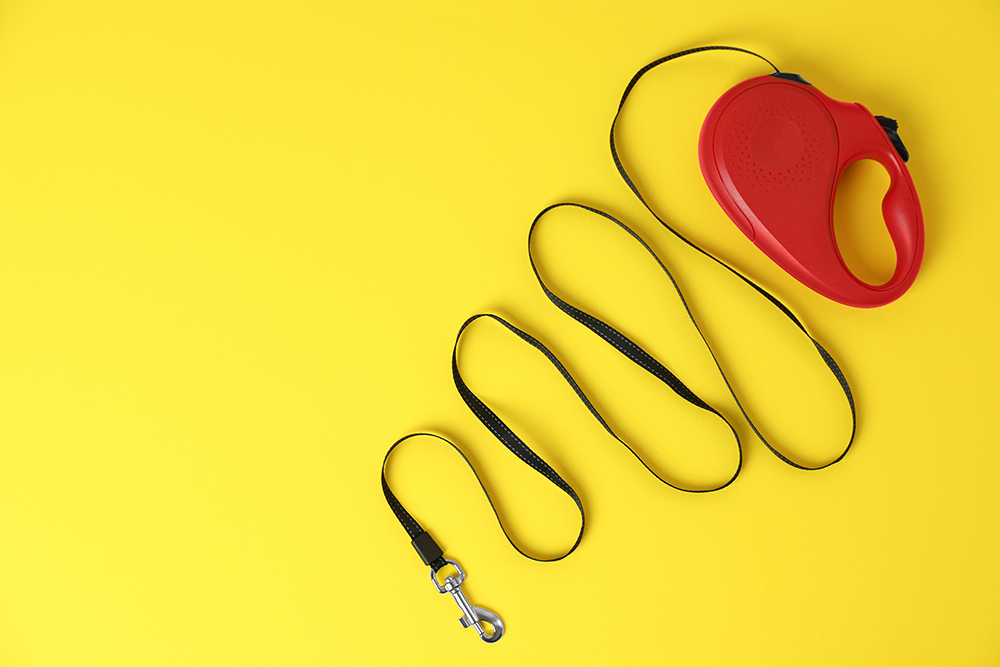The Risks of Using a Retractable Leash
Retractable leashes are popular with dog owners, but few know of their dangers. Learn how retractable leashes can be harmful to you and your pet and what to use instead.

On paper retractable leashes are an amazing invention for dog owners, they give your dog the freedom to sniff and explore their surroundings, which makes the retractable leash type popular with dog owners. But if you ask dog trainers and vets, they will tell you that they loathe retractable leashes because of the significant risks, which can be detrimental even for dogs on their best behavior.
To better understand why retractable leashes are not a dog owner's best friend, we've identified five dangers of using one, read on to learn more about retractable leashes and their risks:
The Locking Function Can Malfunction
The locking function is a safety precaution, enabling you to stop your dog from wandering too far. Sadly, the locks in retractable leashes are not as reliable as you may think.
Whether it be from wear or tear or incorrect assembly, there are times when the locking function doesn't work properly, leading your dog to walk farther than intended.
This can cause dangerous scenarios to occur. For instance, it can allow your dog to invade another dog's personal space. This can result in dogs acting aggressively toward each other or even starting a fight. It may even allow your dog to run into the road and get hit by a moving vehicle.
These risks may be uncommon, but they happen more easily than you think. All it takes is for the lock to malfunction for a few seconds, and your dog can be in danger.
The Jerking Stop Can Cause Injuries To Your Pet
Vets loathe retractable leashes due to the injuries they can cause. Common injuries include neck strain and vertebrae displacement when dogs aggressively pull on the leash. Dogs can also acquire eye injuries if the leash breaks and skin lacerations if the leash gets wrapped around their legs or paws.
The American Journal for Emergency Medicine tracked injuries from retractable leashes from 2001 to 2018. The journal found the number of injuries that required emergency room treatment increased by four times. Over 193,000 injuries were due to pulling, and 136,000 injuries occurred due to tangling.
The fact that injuries are only increasing demonstrates how large the risk is. Retractable leashes don’t cause a few accidents or one or two injuries; there are hundreds of thousands of dogs injured because of a retractable leash.
Retractable Leashes Encourage Pulling
Many dog trainers despise retractable leashes due to the fact that they encourage pulling. After all, retractable leashes never slack, so dogs will feel the tension of the leash and naturally pull to reach their desired destination.
Over time, your dog may develop a negative conditioned response to the tension and continually pull, which can damage the lead. Pulling can also cause damage to a dog's thyroid gland, resulting in long-term health problems like weight gain, lack of energy, and skin problems.
To instill good behavior, many trainers advised against retractable leashes. If you want a longer lead, most trainers suggest a 10 to 15-foot biothane lead.
Since biothane is durable, lightweight, and soft, it won't hurt your dog or snap in half like other leads. It also requires the operator to actively engage with the lead, which helps dogs determine which behaviors are acceptable and non-acceptable while walking.
It's Difficult to Supervise Dogs From Far Away
Retractable leashes allow your dog to roam up to 26 feet ahead of you. The average length of a short school bus is 26 feet, which means retractable leashes can extend the length of a school bus.
Now, not everyone uses the full range of a retractable leash; even so, there are a number of instances that can occur even if your dog is 10 to 15 feet in front of you. If your dog is that far ahead of you, it can be difficult to see what they're doing and know if you need to respond.
For instance, you may think your dog is licking a patch of grass, but in reality, your dog is licking a pile of feces. Other times, your dog may zip in between pedestrians, potentially tripping nearby people or causing the leash to get tangled with other dog leashes.
By allowing your dog to roam so far ahead of you, you're not actively showing your dog what's acceptable behavior and what's not. They might take advantage of the length of the lead and get into trouble if not properly supervised.
Finger and Hand Injuries Can Occur
Retractable leashes can be dangerous not only for your dog but also for you. If a retractable leash wraps around your finger or leg, it can cause minor rope burns and skin lacerations as your dog pulls on the leash. Major injuries like deep cuts and amputation can also occur due to the leash's thin material.
Some retractable leashes even come with warning labels that bring awareness to the product's risks. Even if your dog is well-behaved, accidents do happen, to make sure both you and your dog are safe, purchase other alternatives than a retractable leash. After all, isn't it better to be safe than sorry?
Not All Leashes Are Created Equal
Retractable leashes may seem like a great way to give your dog freedom during their walk. However, retractable leashes aren't 100% reliable, nor are they safe.
Retractable leashes rely on a simple stop mechanism and, with wear and tear, can easily break, causing accidents. The leash can also cause long-term injuries to both you and your dog. If you want to ensure your and your dog's safety, don't use a retractable leash; instead, opt for a leather or biothane leash.
Let us know in the comments if you've heard about these risks. Plus, if you know of any good leash brands, comment below.


